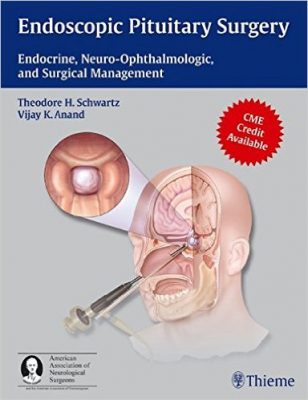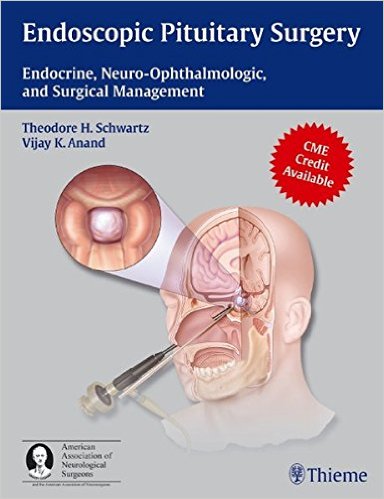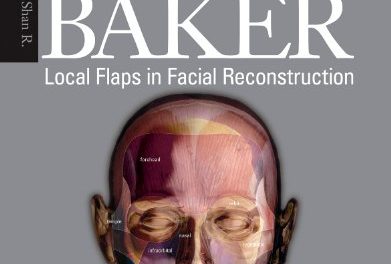 Editors: Theodore H. Schwartz, MD; and Vijay K. Anand, MD
Editors: Theodore H. Schwartz, MD; and Vijay K. Anand, MD
Publisher: Thieme – 358 pages
Book Review by: Nano Khilnani
This book combines insight of experienced surgeons and clear visualization with an endoscope.
Seventy-three specialists in several fields of medicine and surgery, namely endocrinology, endoscopy-ENT surgery, neurology, neuroradiology, neurosurgery, ophthalmology, otolaryngology – head and neck surgery, pathology and laboratory medicine, and pituitary tumor surgery, authored the 34 chapters of this book, which we list below to give you an overview of what you will find in it. The contributing writers are mainly from the United States, but a number of them are from other countries – Austria Canada, Germany, Israel, Italy, Malaysia, and Spain.
- History of Pituitary Surgery
- Anatomy of the Pituitary Gland and Parasellar Region
- Endoscopic Equipment
- Preoperative Endocrine Evaluation
- Radiographic Evaluation of Pituitary Tumors
- Indications for Surgery on Pituitary Tumors: An Endocrinologist’s Perspective
- Indications for Surgery on Pituitary Tumors: A Neurosurgeon’s Perspective
- Histology of Pituitary Tumors
- Prolactinomas and Apoplexy
- Acromegaly
- Cushing’s Disease
- Thyroid-Stimulating Hormone Tumors
- Clinical Management of Nonfunctioning Pituitary Adenomas
- Neuro-Ophthalmologic Considerations
- Endoscopic-Transsphenoidal Approach to the Sella
- Clinical Pearls in Endoscopic Pituitary Surgery: A Neurosurgeon’s Perspective
- Clinical Pearls in Endoscopic Pituitary Surgery: An Otolaryngologist’s Perspective
- Virtual Endoscopy in Endoscopic Pituitary Surgery
- 3D Stereoendoscopic Pituitary Surgery
- Endoscope-Assisted Transsphenoidal Surgery
- Endoscopic Pituitary Surgery in the Cavernous Sinus
- Microscopic versus Endoscopic Transsphenoidal Pituitary Surgery
- Microscopic and Endoscopic Transsphenoidal Pituitary Surgery: A Reasoned and Balanced Dialectic
- Extended Endonasal, Endoscopic Transsphenoidal Approach versus Craniotomy for Giant Pituitary Macroadenomas
- Stereotactic Radiosurgery and Fractionated Radiation for Pituitary Tumors
- Atypical Adenoma, Pituitary Carcinoma, and the Role of Chemotherapy in the Management of Refractory Pituitary Adenoma
- The Utility of Intraoperative MRI in Pituitary Surgery
- Limited Utility of Intraoperative MRI in Endoscopic Pituitary Surgery
- The Role of Stereotactic Navigation in Endoscopic Pituitary Surgery
- Anesthesia Considerations
- Managing Postoperative Sinusitis
- Managing Carotid Injury During Transsphenoidal Surgery
- Managing Postoperative Cerebrospinal Fluid (CSF) Leak
- Postoperative and Neurocritical Care Management of Patients after Endonasal Endoscopic Transsphenoidal Surgery
This book provides a bridge between the past history of pituitary surgery and its present state and future potential. It is about the innovative, endoscopic, minimal-access surgical techniques on the anterior skull base, particularly on the pituitary gland. It presents detailed information pertaining to the history, diagnosis, surgical treatment, and medical management of diseases of this gland.
It starts out with a brief historical perspective in which Russel Patterson relates to us that it was in 1889 when Sir Victor Horsley performed the first resection of a pituitary adenoma utilizing the transcranial route. He writes: “Techniques for chiasmal surgery were poorly developed at that time and accompanied by substantial morbidity, which led to the development of other approaches, notably the transsphenoidal technique as first performed by Schloffer in 1907.”
But Sir Harvey Cushing, the ‘father of modern neurosurgery’ preferred using the cranial approach, which ‘no doubt was an important factor in slowing down the adoption of transsphenoidal surgery,’ Patterson points out.
The transcranial approach was attractive and became popular because it enabled the surgeon to view clearly the pathological changes that affected the optic nerve and chiasm, and make the necessary adjustments while operating. The endoscope enabled the surgeon not only to get clear views, but wide ones as well.
But let us also not forget the great contributions of pioneering pituitary surgeons of the past, who, while not having the privilege of using an endoscope, amassed and passed on their knowledge and insight to those that followed them in the field of neurosurgery.
Technological developments – such as the evolution of air studies, computed tomography (CT), magnetic resonance imaging (MRI), and computer-guided navigation – have made it possible to get better views of adenomas on and around the pituitary gland (and other sections of the anterior skull base) prior to performing surgical procedures.
These advances have made the transsphenoidal approach less invasive, more attractive, and a popular choice of surgeons for about 40 years, Patterson points out.
This book contains a large number and variety of excellent images that help you to learn and absorb knowledge more easily. It has charts, drawings, photos (of equipment, instruments, organs, tissues, and x-rays.
The materials in each chapters are very well organized and presented, typically with introductory paragraphs, presentation, and detailed and well-illustrated discussions of topics and subtopics, a Conclusion, Acknowledgments, and References. This is book is a valuable and rare asset, as there are very few books on there on the subject of minimally-invasive, endoscopic pituitary surgery.
Editors:
Theodore H. Schwartz, MD, FACS is a Professor in the Departments of Neurological Surgery, Otolaryngology – Head and Neck Surgery, and Neurology and Neuroscience at Weill Cornell Medical College; and Attending Neurosurgeon in the Department of Neurological Surgery at New York Presbyterian Hospital in New York, New York.
Vijay K. Anand, MD, FACS is a Clinical Professor in the Department of Otolaryngology – Head and Neck Surgery at Weill Cornell Medical College and New York Presbyterian Hospital in New York, New York.







